科学文献

With the deepening of scientific research and practical verification, people's attitude towards cancer has gradually changed from "talking about cancer and changing color" to "coexisting with cancer". But even now, cancer is still a major public health problem worldwide and the primary factor causing the global disease burden. On February 2, 2024, the World Health Organization's International Agency for Research on Cancer ( IARC) released the latest Global cancer burden growing, amidst mounting need for services , which once again emphasized that the current increasing global cancer burden deserves worldwide attention.
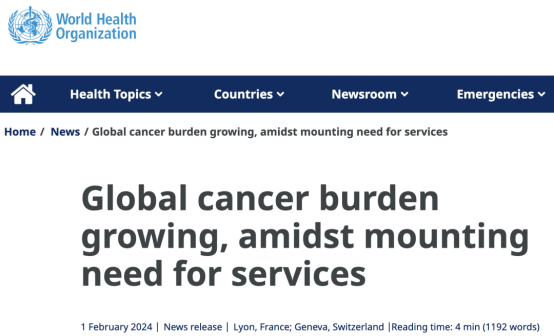
Image source: WHO
In summary, ① In 2022, the number of new cancer cases worldwide will reach 20 million, and the number of deaths will reach 9.7 million ; ② It is estimated that within 5 years after being diagnosed with cancer, the number of survivors is 53.5 million; ③ About 1/5 of people will develop cancer in their lifetime, and about 1/9 of men and 1/12 of women will die from cancer. Looking at the world, after a specific analysis of 36 types of cancer in 185 countries, IARC concluded that the "three major cancer types in 2022" are lung cancer, breast cancer, and colorectal cancer . Among them, lung cancer is the most common type of cancer in the world, with 2.5 million new cases in 2022, accounting for 1/8 (12.4%) of the total number of new cancer cases. Not only that, the number of people who died from lung cancer worldwide reached 1.8 million, accounting for 18.7% of the total number of cancer deaths, ranking first on the cancer "death list". Comparing the number of new cancer cases , we found that lung cancer ( 2.5 million, 12.4%) > female breast cancer (2.3 million, 11.6%) > colorectal cancer (1.9 million, 9.6%) > prostate cancer (1.5 million, 7.3%) > gastric cancer (97 million, 4.9%). Comparing the number of cancer deaths , we found that lung cancer ( 1.8 million, 18.7%) > colorectal cancer (90 million, 9.3%) > liver cancer (76 million, 7.8%) > breast cancer (67 million, 6.9%) > gastric cancer (66 million, 6.8%).
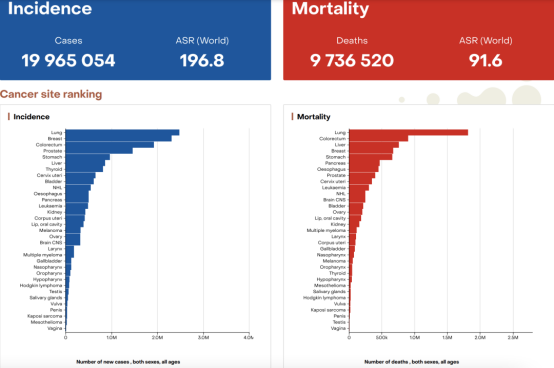
Number of cancer cases and deaths (Source: Cancer Today)
However, the data changes when classified by gender. Among women, the most commonly diagnosed cancer and the leading cause of cancer death are breast cancer , with lung cancer and colorectal cancer ranking second and third in terms of new cases and deaths, respectively. Among men, lung cancer has the highest number of new cancer cases , followed by prostate cancer and colorectal cancer ; lung cancer still has the highest number of cancer deaths , followed by liver cancer and colorectal cancer .
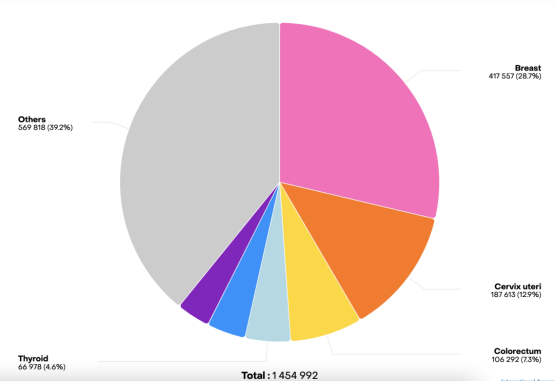
Cancer incidence in women
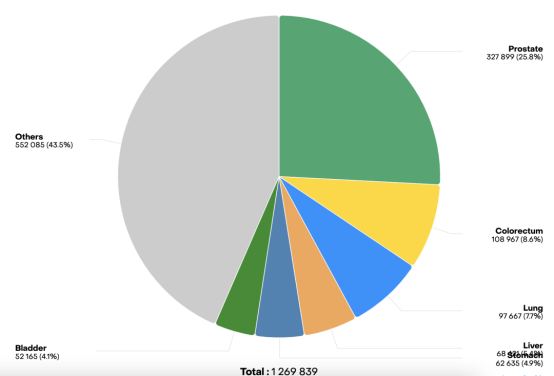
Cancer incidence in men
IARC made some deductions based on the existing data and expressed new concerns: the global cancer burden is expected to increase further by 2050! Data show that the number of new cancer cases in 2050, about 30 years later, will exceed 35 million, an increase of 77% from 20 million in 2022; at the same time, by 2050, the cancer mortality rate is likely to double. Researchers said that the rapid growth of the global cancer burden directly reflects two current situations: one is the aging and rapid population growth of the population; the other is that with the development of social economy, people are exposed to changes in risk factors. For example, tobacco, alcohol and obesity are key factors in the increase in cancer incidence, while air pollution is still the main driver of environmental risk factors. It is worth mentioning that it is not easy to solve this problem. When divided according to the Human Development Index (HDI), an astonishing "cancer inequality" phenomenon will be observed. (HDI is an indicator used to measure the economic and social development level of each member state of the United Nations. Among them, more than 0.9 is a developed country, and more than 0.85 is a quasi-developed country. China is about 0.768)
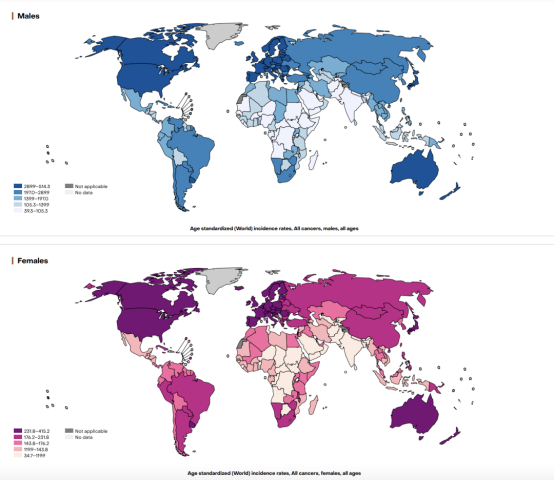
Cancer incidence by gender (Source: Cancer Today)
Take breast cancer as an example. In countries with high HDI, 1 in 12 women will be diagnosed with breast cancer and 1 in 71 will die from it. In contrast, in countries with low HDI, 1 in 27 women will be diagnosed with breast cancer, but 1 in 48 women will die from it. "Women in countries with low HDI are 50% less likely to be diagnosed with breast cancer than those in countries with high HDI, but they are at a much higher risk of dying from cancer because of late diagnosis or lack of timely and high-quality treatment," explained Isabelle Soerjomataram , deputy director of the surveillance department of IARC. If this imbalance cannot be improved, the difference may be further amplified by 2050. Although in terms of absolute burden, countries with high HDI will see the largest absolute increase, with an estimated 4.8 million new cases; the proportion of cancer incidence in countries with low HDI and medium HDI will increase by 142% and 99%, respectively, which is quite astonishing. Of course, there is still a long way to go to adjust the imbalance of global cancer. On the other hand, the cancer situation in China is not optimistic either. In December 2023, a research team from the Chinese Center for Disease Control and Prevention summarized the national cancer burden trend from 2005 to 2020 based on data from more than 300 million Chinese people, and found that the total number of cancer-related deaths increased by 21.6%; among them, the top three causes of death were lung cancer, liver cancer, and stomach cancer. The study was published in Lancet Public Health .

DOI: https://doi.org/10.1016/S2468-2667(23)00211-6
Statistics show that in 2020, the number of cancer-related deaths in China reached 2,397,772, an increase of 21.6% compared to 2005. At the same time, the number of years of life lost (YLL) rose to 56,598,975, an increase of 5.0% compared to 15 years ago. In the past 15 years, in addition to the increase in the number of deaths, China's cancer type map has also changed to a certain extent. Calculated by the dimension of mortality rate, the top five cancers for men have hardly changed, ranking as follows: trachea, bronchus and lung cancer > liver cancer> gastric cancer> esophageal cancer> colorectal cancer . However, the order of cancers ranked 6-12 has undergone certain adjustments. There have been major changes in women . Calculated by mortality rate in 2020, the top five cancers are: trachea, bronchus and lung cancer > liver cancer> gastric cancer> colorectal cancer> breast cancer . Among them, the positions of trachea, bronchus and lung cancer remained unchanged and always ranked first; liver cancer rose from the third place to the second place, colorectal cancer rose from the fifth place to the fourth place, and breast cancer rushed to the fifth place; while gastric cancer dropped from the second place to the third place, and esophageal cancer dropped out of the top five.
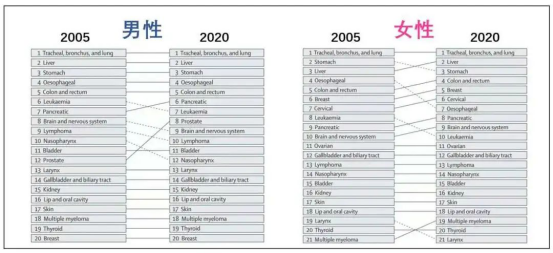
Cancer ranking by sex and year
However, differences in rural /urban, age, and province will lead to differences in cancer mortality and YLL. For example: the types of cancer in urban areas are beginning to approach those in developed countries, and the relative mortality rate of colorectal cancer has increased, especially in Beijing, Shanghai, and Guangzhou; there are large differences in the order of cancer causes of death among different age groups, and young people aged 0-19 are more susceptible to leukemia, brain cancer, and nervous system cancer, while the middle-aged group aged 40-59 is more likely to be affected by liver cancer, lung cancer, and breast cancer. In fact, by comparing the situation in China with the world, it can be found that China's cancer incidence rate is close to the world average, but the mortality rate is much higher than the global average and high-income countries. This difference is largely due to the "lower five-year survival rate of major cancers."
Therefore, the researchers once again emphasized the importance of cancer screening and prevention, and called on everyone to develop a healthy lifestyle and work together to get rid of "tumor"!
